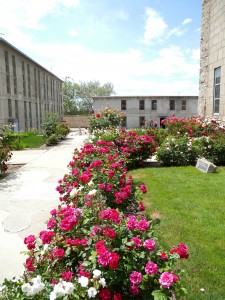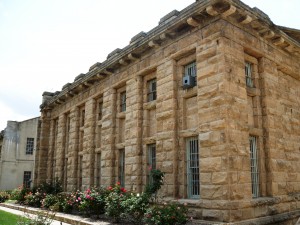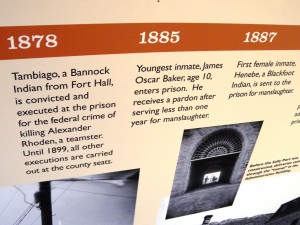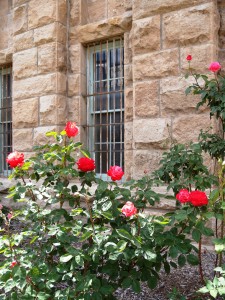» posted on Tuesday, May 22nd, 2012 by Linda Lou Burton
Just Visiting
 Linda Burton posting from Boise, Idaho – In Monopoly, you scowl when your token lands on that unlucky space marked “Go To Jail;” you do not collect $200; you move directly into Jail. Your turn is up. Land on the “Jail” space in the ordinary course of play and you are Just Visiting; life is good. The Old Idaho Penitentiary off Warm Springs Road has lots of folks “just visiting” these days; the former territorial prison closed for good in 1973 after more than a hundred years of housing the “bad guys” and a few “bad women” too. Now a part of Idaho history, the Idaho Historical Society has it open to the public; it is a designated National Historic Site. A family bought their tickets just ahead of me; the parents and two girls, a teen and what looked to be a ten-year-old, a pretty little blond. The first exhibit room had costumes and a camera stand; put on the stripes and pose before a blackout screen; or stand behind the bars. The little girl did both; dramatic scenes; she pulled a look of anguish out; I heard the camera click. The teen played cell phone games, not much impressed. Just visiting. I headed for the gate into the Yard. “Don’t miss Siberia,” the lady selling tickets said. “It’s the worst.”
Linda Burton posting from Boise, Idaho – In Monopoly, you scowl when your token lands on that unlucky space marked “Go To Jail;” you do not collect $200; you move directly into Jail. Your turn is up. Land on the “Jail” space in the ordinary course of play and you are Just Visiting; life is good. The Old Idaho Penitentiary off Warm Springs Road has lots of folks “just visiting” these days; the former territorial prison closed for good in 1973 after more than a hundred years of housing the “bad guys” and a few “bad women” too. Now a part of Idaho history, the Idaho Historical Society has it open to the public; it is a designated National Historic Site. A family bought their tickets just ahead of me; the parents and two girls, a teen and what looked to be a ten-year-old, a pretty little blond. The first exhibit room had costumes and a camera stand; put on the stripes and pose before a blackout screen; or stand behind the bars. The little girl did both; dramatic scenes; she pulled a look of anguish out; I heard the camera click. The teen played cell phone games, not much impressed. Just visiting. I headed for the gate into the Yard. “Don’t miss Siberia,” the lady selling tickets said. “It’s the worst.”
 To my surprise, roses greeted me. Not just one thorny bush, but rows of color lined the walk, pinks and yellows brightened up the sandstone walls and gray iron window bars. I could smell the roses too, it was very pleasant there. I looked down at the Walking Guide I held. According to the map, 2 House was on my right. “Built in 1899. The building contains two-man cells and no indoor plumbing. A bucket in the corner served as a toilet. Inmates burned the building in a 1973 riot.” I kept walking. 3 House, built in 1921, condemned for habitation, it was a shoe factory. Remodeled in 1928, the first cell house with indoor plumbing.” I re-adjusted my thought. Pleasant, if you are just visiting.
To my surprise, roses greeted me. Not just one thorny bush, but rows of color lined the walk, pinks and yellows brightened up the sandstone walls and gray iron window bars. I could smell the roses too, it was very pleasant there. I looked down at the Walking Guide I held. According to the map, 2 House was on my right. “Built in 1899. The building contains two-man cells and no indoor plumbing. A bucket in the corner served as a toilet. Inmates burned the building in a 1973 riot.” I kept walking. 3 House, built in 1921, condemned for habitation, it was a shoe factory. Remodeled in 1928, the first cell house with indoor plumbing.” I re-adjusted my thought. Pleasant, if you are just visiting.
 Down some steps and on around the Yard, I’m looking for Siberia. Siberia. The Worst. Stuck back in the corner of the Yard, a windowless white-plastered box; one door. I hesitated just outside. I know that it’s been empty almost 40 years, but what ghosts remain? I barely peeked. Solitary, built in 1926, 3 x 8 foot cells, no light. I walked back to the pretty roses, sat down on a bench and read more in the Guide.
Down some steps and on around the Yard, I’m looking for Siberia. Siberia. The Worst. Stuck back in the corner of the Yard, a windowless white-plastered box; one door. I hesitated just outside. I know that it’s been empty almost 40 years, but what ghosts remain? I barely peeked. Solitary, built in 1926, 3 x 8 foot cells, no light. I walked back to the pretty roses, sat down on a bench and read more in the Guide.
The Historical Society provides a number of exhibits so the visitor can see, and understand, a little bit of prison life. Prisoners and Riots, in 2 House; Contraband in 4 House; a weapons exhibit in the old Shirt Factory. Several areas are closed to the public at the present time; renovation and restoration going on; no access to the Rose Garden, where 6 of the 10 Old Pen executions occurred, all by hanging. And no access to 5 House, the maximum security building, which includes a built in gallows and Death Row.
 I want some background now; why was it built here, and when? Sandstone is the answer to my first question; the four and a half acre site was close to available sandstone; the buildings were built by inmate laborers. The first prisoners were brought in 1872. In 101 years, the Penitentiary received over 13,000 inmates; 222 of them were women; ages ranged from 10 to 82.
I want some background now; why was it built here, and when? Sandstone is the answer to my first question; the four and a half acre site was close to available sandstone; the buildings were built by inmate laborers. The first prisoners were brought in 1872. In 101 years, the Penitentiary received over 13,000 inmates; 222 of them were women; ages ranged from 10 to 82.
The design of the prison reflects important changes in attitudes. Reform of the penal system was a goal of religious thinkers after the American Revolution. Quakers believed that prisons should be penitentiaries, places of penance. The “Pennsylvania” system placed emphasis on isolation, confinement, and attendance at religious services, to allow the criminal the opportunity for remorse. It was gradually discarded after the 1820’s, mainly due to the high suicide rate among prisoners.
 New York was the first state to change policies; at its new Auburn Prison inmates were confined to individual cells at night, but worked and ate together. This benefitted the mental health of convicts and made assembly-line labor possible, an economic resource for the prison. Sing Sing, San Quentin, and the Idaho Penitentiary were modeled on the Auburn system.
New York was the first state to change policies; at its new Auburn Prison inmates were confined to individual cells at night, but worked and ate together. This benefitted the mental health of convicts and made assembly-line labor possible, an economic resource for the prison. Sing Sing, San Quentin, and the Idaho Penitentiary were modeled on the Auburn system.
The National Prison Association, formed by private individuals in 1870, lobbied for the reform of criminals through education and vocational training. Wardens argued that involvement of prisoners in some kind of work is the best agent for preserving order, and also keeps them in better health.
 A building at the Old Pen gives evidence of that. The dining room of 1898 was designed by convicted robber George Hamilton; he was pardoned after its completion. The building also served as a hospital, chapel, bakery and laundry. And then, lining the sidewalks in perfumed splendor, there are the roses. They meant as much to their original gardeners, I’m thinking, as they do to those who come today, just visiting.
A building at the Old Pen gives evidence of that. The dining room of 1898 was designed by convicted robber George Hamilton; he was pardoned after its completion. The building also served as a hospital, chapel, bakery and laundry. And then, lining the sidewalks in perfumed splendor, there are the roses. They meant as much to their original gardeners, I’m thinking, as they do to those who come today, just visiting.
Visit the Old Idaho Penitentiary @ 2445 Old Penitentiary Road, Boise, Idaho
http://history.idaho.gov/old-idaho-penitentiary
